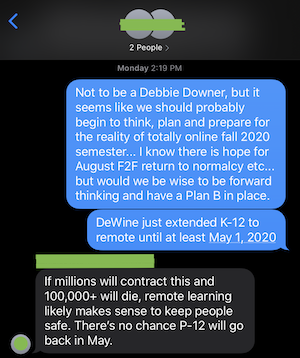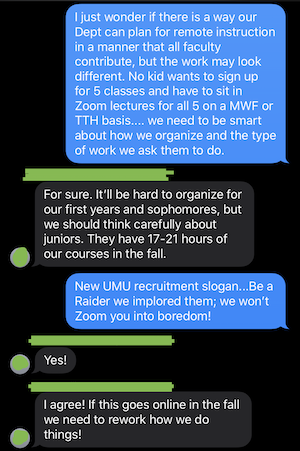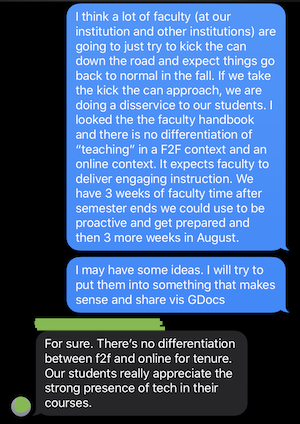-
1
Apr
For better or for worse, the COVID-19 pandemic has changed us all. Like most educators across the country, I’ve been scrambling to adjust and transition my classes to the online space. As someone who has worked in eLearning design and development since about 2007, I feel fortunate to have a background that made this transition fairly easy for me. I know this isn’t the case for everyone and I am empathetic to their struggles, however, as more days have gone past, I’ve had a feeling that we might not make it back to our physical spaces just this year, but a return next fall may be in danger too. If this happens, it will truly be, as Future puts it, MASK OFF, for all educators. We will have nothing to hide behind.
I started having the, “we should prepare for fall online” conversation with a couple of my colleagues earlier this week. I think it is an important one for all educators to begin engaging in, so I am going to share some of my initial thoughts. Please note, this is the rough cut. The polish isn’t there yet, but I am hoping that making my thinking transparent and public others will chime in.
Here are a few snippets from my initial comments to people I teach with. I’m in blue, my colleagues in grey.



So, I planted the seeds at the beginning of this week and then what did I come across today (hat tip to my father-in-law)? This article on the Inside Higher Ed website titled, Preparing for a Fall Without In-Person Classes. Ooooh golly! Here we are! If I was a gambler, I think I’d take the odds that we don’t go back to business as usual on campuses this fall.
So what does that mean and how do we prepare?
I’ll start by saying, I don’t really know. I will lay out some initial building blocks of thought though. I have them in a Google Doc here, but for simplicity I will share them in this post too. I think they are that important and we all should chew on them for a while.
Realignment of course design responsibilities is necessary in order to develop meaningful and engaging online or blended instruction across our programs. We can not continue to look at course offerings as belonging to a specific faculty member. We can not continue to look at students as ours, only if they appear on our course roster. It is time to think beyond the classroom and into the future of education. An education that has increasingly less to do with playing school and significantly more to do with blended delivery of guided inquiry.
To make this shift, we must first reimagine what our role as faculty looks like. Our own handbook* provides the flexibility to do just this. “The principal teaching responsibility of a faculty member is to prepare and conduct academic courses in a manner to stimulate learning by students” (p 28). We must re-imagine our faculty as a whole, with each of us a critical part of that whole, possessing our specific strengths and weaknesses. Each faculty member works together, utilizing their own specific strengths, to ensure all students in our programs progress through all courses with proficiency. This can not be accomplished designing, developing and teaching individual courses in silos.
A potential re-design model of faculty roles may look like:
Content Area Expert (CAE)
- Identify course content that is aligned with course objectives
- Work with LED to sequence content into modules
- Develop lecture and presentation materials for modules
- Develop assessment materials that reflect proficiency in content
- Work with LED and EIC to create course assignments and activities (traditional, online, IRL)
Learning Experience Designer (LED)
- Create digital asset templates for standardized course content
- Build course specific digital assets from CAE materials for each module
- Develop Brightspace and other digital learning spaces
- LO Repository
- Question Library/Quizzes
- Work with CE and EIC to create course assignments and activities (traditional, online, IRL)
Embedded Instructional Coach (EIC)
- Work with CAE and LED to create course assignments and activities
- Provide onsite mentoring and feedback to candidates in field/clinical placements
- Conduct F2F mini-lessons over content/instruction/assessment based on emerging candidate needs
- Work with LED to research and curate resources/supplemental material for every subject matter
- Communicate candidate proficiency with ICA and identify areas for growth/mini-lessons
Internal Course Auditor (ICA)
- Maintain Brightspace, Starfish and Watermark data as course requires
- Communicate candidate proficiency with EIC and identify areas for growth/mini-lessons
- Examine and audit candidate materials using aligned rubrics and/or other metrics
- Create and distribute reporting materials and progress updates for candidates, EIC, cooperating teachers
- Develop reports and materials required for various accreditation agencies
As I said before, I don’t have the answers. I have thought, ideas and ramblings. One thing I do know, however, is that our students deserve our urgent attention to this matter! With some institutions already projecting fall enrollment to be down, we can’t just take our traditional classroom and try to re-create it online. We can’t Zoom lecture our students into oblivion. We have to find another way and we can’t go back to what it was that made us comfortable before. It’s time for Mask Off. We owe that to our students. We should see this coming. We should be prepared for when it gets here.
* I am referencing my institution specific faculty handbook. Of course, this will vary from institution to institution.
- Published by brueckj23 in: Raised Digital Teacher Education University of Mount Union
- If you like this blog please take a second from your precious time and subscribe to my rss feed!

One Response to “I Don’t Think We Should Ever “Go Back To Normal””
Leave a Reply